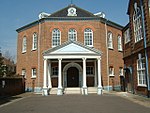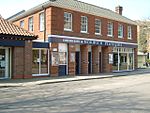Surrey Chapel, Norwich
Churches in NorwichEnglish church stubsEvangelical churches in the United Kingdom

Surrey Chapel is a Free Evangelical church in Norwich, Norfolk, England. It was founded in 1854 by the Evangelical Robert Govett, in a public hall in Surrey Street (which has been called 'no earthly gem' architecturally). It is perhaps best known as being home to the missionary Elsie Tilney, who, during World War II, travelled to Vittel to assist in the rescue of Jews and other foreign nationals imprisoned by Nazi Germany. The church was also attended by British missionary Margaret E. Barber. In the twenty-first century, the chapel was known for its work in the local community, including debt advice, and participation in the local football league.
Excerpt from the Wikipedia article Surrey Chapel, Norwich (License: CC BY-SA 3.0, Authors, Images).Surrey Chapel, Norwich
Botolph Street, Norwich New Catton
Geographical coordinates (GPS) Address External links Nearby Places Show on map
Geographical coordinates (GPS)
| Latitude | Longitude |
|---|---|
| N 52.6354 ° | E 1.2931 ° |
Address
Surrey Chapel
Botolph Street 2-6
NR3 1DU Norwich, New Catton
England, United Kingdom
Open on Google Maps











